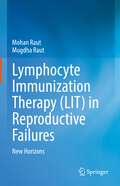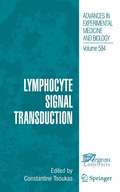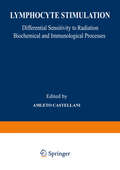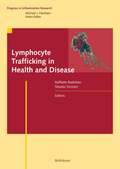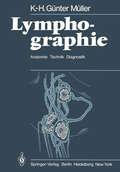- Table View
- List View
Lymphocyte Hybridomas: Second Workshop on “Functional Properties of Tumors of T and B Lymphoyctes”
by F. Melchers M. Potter N. L. WarnerSponsored by the National Cancer Institute (NIH)
Lymphocyte Immunization Therapy (LIT) in Reproductive Failures: New Horizons
by Mohan Raut Mugdha RautRecurrent Miscarriages (RM) & Implantation Failure (IF) have remained an enigma to clinicians and researchers. Even after ruling out all possible causative factors, 50-60% cases still remain “Unexplained’. A majority of these so called “Unexplained” cases are now found to have immunological basis.This book is going into the Immunological aspects of these clinical dilemmas, demystifying the role of Immunology and Immunotherapy in RM and IF. The authors have been working in the field of Reproductive Immunology and Immunotherapy for the last 25 years and they have come out with this book combining the international studies with their own experience. The purpose of writing this book is to provide a comprehensive treatise about Immunotherapy, so that it can become an acceptable modality of treatment in cases where it is needed and is effective.The book discusses the basics in Reproductive Immunology. The immunological changes occurring during pregnancy, the role of Cell mediated Immunity (T cells), Humoral Immunity including cytokines is explained. The normal immunological mechanisms protecting the embryo are highlighted and how these mechanisms are disturbed leading to RM and IF, is also explained.The first and the most discussed method of Immunotherapy is Lymphocyte Immunization Therapy (LIT). The book has given a complete overview of LIT, describing how it created euphoria when it was first introduced, how it gradually went into disrepute and how it is now making a comeback. As the authors have personal experience of LIT, the book gives a detailed and complete information about this active form of immunotherapy.The book has a special section on case studies where the authors have given some clinical case reports (including some of their own), who were treated for immunological factor in RM/IF and were treated with Immunotherapy. These cases can be a useful guide to the readers.The book will be useful not only for undergraduate and postgraduate students but also for clinicians in their practice and for researchers for review of developments in the field.
Lymphocyte Signal Transduction
by Constantine TsoukasThis is the third workshop on this topic that took place in Crete from May 27 to June 1, 2005. Similar to the two previous workshops, held in Santorini October 2000 and 2002 respectively, the purpose of this workshop is to bring together scientists from all over the world to discuss their latest findings on the various aspects of lymphocyte signal transduction. The participants represented academia, industry, foundation and governmental laboratories.
Lymphocyte Stimulation: Differential Sensitivity to Radiation Biochemical and Immunological Processes
by AmletoCastellaniThis book is a collection of some of the papers presented at the EMBO Lecture Course on "Lymphocyte stimulation: differential sensitivity to radiation; biochemical and immunological properties." The Course was organized with the aim of fostering interactions between photoradiobiologists and immunologists interested in the problem of DNA damage and repair studied at the lymphocyte level. The papers presented in this book are mainly centered on the problem of radiation sensitivity of lymphocytes in relation to DNA repair phenomena. The radiation biology of human lymphocytes is dominated by two phenomena: (a) high radiosensitivity of lymphocytes which die in interphase (b) PHA-induced relative radioresistance of those cells which, after stimulation, escape the interphase death and eventually die in mitosis. These phenomena constitute a good system to study some of the factors which control the response of human cells to irradiation. In addition it is possible to correlate the development of the relative radioresistance in PHA-stimulated lymphocytes with the biochemical changes connected with the transformation processes. The papers presented in this book constitute a real contribution to the scientific knowledge in this field of research and suggest that lymphocytes could be a very interesting test material useful for measuring the DNA repair capability of human cells to furnish an indication of individual radiosensitivity in man.
Lymphocyte Trafficking in Health and Disease (Progress in Inflammation Research)
by Raffaele Badolato Silvano SozzaniThis book deals with the description of the role of chemokines in immune response and underlines potential targets of therapeutical intervention. It offers a series of international contributions of the most challenging aspects of lymphocyte migration in homeostasis and in disease, and has a special focus on diseases and targets of therapeutical intervention. The book will interest researchers and clinicians from inflammation research.
Lymphocytes in Immunotherapy of Cancer
by Karl-HeinzVosteen LutwinBeck UrsulaKoldovsky PaulKoldovskyIn the past, research in cancer immunology has produced informa tion important for other medical disciplines. It helped, for example, in formulating the laws of immunogenetics and in achieving a better understanding of the mechanism governing the fate of allotrans planted tissue. Cancer has often been considered a foreign body, and therefore many attempts have been made to cure it on the basis of the immunological principles applicable to parasitic, bacterial, or viral diseases. Vaccination has been investigated clinically for its po tential to prevent cancer [1], and clinical research into the cure of cancer has included active immunization [2], nonspecific stimulation of defense mechanisms [3], and transfer of passive immunity by cells [4] or by antibodies [5]. These experiments have been of limited value and in some cases have even had an adverse effect. The reputation of cancer immunology has suffered, and the concept has often been severely criticized. However, the basic postulate that cancer must originate from the body's own cells, and that the immune system belongs to the principal regulatory mechanisms, remains valid. In recent years new research into clinical cancer immunotherapy has included critical appraisal of all its potential benefits, and also of the risks and limitations. It is dangerous to make unrealistic promises or to speak or think in terms of "miracle weapons" or a "magic bul let.
Lymphocytes, Macrophages, and Cancer (Recent Results in Cancer Research #56)
by Georges Mathé, Irène Florentin and Marie-Christine SimmlerFresh living Bacillus Calmette-Guerin (BeG), injected i.v. into (C57BI/ 6xDBA/2)FI mice, activated peritoneal macrophages rendering them highly cytotoxic for tumor cells in vitro. This cytotoxic activity w~s already maximal 14 days after injection of 1 mg of BCG and remained stable when 3 or 5 mg of BCG were given. At the same time spleen cells of the BCG-treat~d mice showed strongly depressed responses to the T-cell mitogens,PHA and Con A, irrespective of the dose of BCG injected. The inhibitory effect was shown to be mediated by suppressor cells which had characteristics of macrophages since they could be removed by carbonyl iron and magnet treatment and were adherent to plastic. In contrast to it was observed after injec tion of 1 mg of BCG, these suppressor cells alone did not account for the depression of T-cell re.sponses induced by higher doses of BCG. Nylon-nonadherent cell populations obtained from spleen cells treated with 3 or 5 mg BCG partially retained the inhibitory activity suggesting that suppressor T cells were also induced after injection of high doses of BCG. In contrast, the responses to the B-cell mitogen LPS of unfractionated and macrophage-depleted spleen cells were not affected or significantly enhanced depending on the dose of BCG injected.
Lymphocytic Choriomeningitis Virus (Virology Monographs Die Virusforschung in Einzeldarstellungen #10)
by F. Lehmann-GrubeI. Introduction Of the ever increasing number of viruses known to affect man and higher animals, the virus of lymphocytic choriomeningitis (LCM) was one of the first to be discovered. Indeed, this virus has been known and maintained in the laboratory by passages in a relatively simple host, the mouse, for 35 years. Yet our knowl edge of its properties is still scanty when compared with the wealth of informa tion available for other viruses, some of which have come to our attention much more recently. There are at least four reasons which may help to explain this seeming paradox. (1) The early belief that the LCM virus was the frequent cause of human diseases had soon to be abandoned; infections of man with this virus are rare. (2) By way of contrast, laboratory infections are not uncommon and they frequently run severe and even fatal courses. (3) Until recently, the only means of titrating the virus was by mouse inoculation, a method in which accuracy and economy are poorly correlated. (4) The virus is of unusual lability, being quickly inactivated under conditions which leave other viruses intact. Thus, when balancing medical and theoretical importance against personal hazard and tech nical difficulties, the result was quite unfavorable, and lack of interest was really not surprising. In the last few years, however, the situation has gradually changed and an increasing number of workers have turned their attention to this virus.
Lymphocytic Choriomeningitis Virus and Other Arenaviruses: Symposium held at the Heinrich-Pette-Institut für experimentelle Virologie und Immunologie, Universität Hamburg, October 16–18, 1972
by F. Lehmann-GrubeFour decades ago, lymphocytic choriomeningitis virus was discovered, at about the same time and independently, in 3 different localities in the U.S.A. Armstrong and Lillie encountered the agent in a monkey when they passaged a recent isolate of the St. Louis encephalitis virus; Rivers and Scott isolated 5 strains from patients with meningitis; and Traub revealed the virus in a colony of albino mice. Already in these first isolations mice were incriminated, and later observa tions proved beyond doubt that M. musculus is the principal reservoir of the virus in nature. For some time LCM virus was regarded as the sole etiologic agent of Wallgren's "meningite aseptique aigue". Soon, however, it became clear that Wallgren's syndrome had a multitude of causes, among which the LCM virus was of little relevance, and in subsequent years it disappeared from the sight of most viro logists. Indeed, it might have fallen into oblivion had it not been for Erich Traub who, practically all by himself, continued to investigate the intricate relationship between this virus and its natural host, the common house mouse.
Lymphoedema Care
by Mary Elizabeth WoodsLymphoedema is managed most successfully when advice and treatment are provided at an early stage of its development. This book provides all the necessary knowledge and the skills required to identify risk factors for the development of the disease and to equip the health care professional in providing the best advice to the patient. As well as examining the physical signs and symptoms of lymphoedema, the book explores the different types of lymphoedema and reasons for its development. It includes a framework for the assessment of the person with lymphoedema, addresses skin care, compression, and the role of exercise and movement in lymphoedema management. It also examines potential complications of the condition and possible effects upon a patient’s lifestyle. Lymphoedema Care is an invaluable resource for students, nurses and other health professionals wishing to understand more about lymphoedema. • Promotes care of the ‘at risk’ limb in order to minimise problematic swelling • Enables nurses to identify complications and recognise the need for referral • Includes case studies
Lymphohaematopoietic Growth Factors in Cancer Therapy (ESO Monographs)
by Roland MertelsmannRecent experimental and clinical progress in the evaluation of cytokines in treatment concepts for cancer patients is the central theme of this book in the ESO Monographs series. The discussion revolves on the experimental basis as well as current clinical experience with the use of human recombinant cytokines. It gives the state of the art and, as such, puts into perspective potential areas of growth and future research.
Lymphoid Neoplasias I: Classification Categorization Natural History (Recent Results in Cancer Research #64)
by Georges Mathé, Maxime Seligmann and Maurice TubianaCNRS International Colloquium, Held in Paris on June 22-24, 1977
Lymphoid Neoplasias II: Clinical and Therapeutic Aspects (Recent Results in Cancer Research #65)
by Georges MathéWe have studied 24 cases of secondarily leukemic (stage V) lymphosarcoma (LS), 31 cases of "d'emblee" leukemic LS, and ten cases of lymphoid leukemic neoplasias transitional between "d'emblee" leukemic LS and chronic lymphocytic leukemia (eLL). These cases only concern the common types ofthe WHO classification ofLS, i.e., the prolymphocytic, the lymphoblastic, and the immunoblastic. Some cases have also been classified by cell surface markers. The secondarily leukemic conversion occurred in 40% of the lymphoblastic types, in 14% of the prolymphocytic types, and in 17% of the immunoblastic types. It never occurred at stage I but could occur after any other stage. The mediastinal involvement was observed in three types, but most often in the lymphoblastic type. The prognosis after an acute lymphoid leukemia (ALL) treatment comprising active immunotherapy following chemo(radio)therapy is better for the leukemic prolymphocytic and lymphoblastic LS than for the immunoblastic type. Two patients (one of the lymphoblastic type) are in complete remission after 8 and 5 years, respectively. We have described ten cases of "d'emblee" leukemic LS with either large lymphoid or extra lymphoid masses, bone marrow leukemic cell involvement, and LS aspects of neoplastic cells. Mediastinal, abdominal, or other tumor masses are frequent.
The Lymphoid Neoplasms 3ed
by Ian MagrathThis comprehensive and authoritative reference covers all aspects of the group of disorders collectively known as the lymphoid neoplasms. The reader is taken through a description of its normal cellular origins and the molecular genetic abnormalities that can lead to this group of conditions, a section of the book that has been considerably strengt
Lymphoid Organogenesis: Proceedings of the Workshop held at the Basel Institute for Immunology 5th–6th November 1999 (Current Topics in Microbiology and Immunology #251)
by Fritz MelchersIt has been clear for a long time that after transplantation of a lymphoid organ, hematopoietic stem cells can regenerate the compartments of the organ, provided that the rest of its architecture - the strome, the epithelia and the vessels - is intact. Ahead lies the even greater challenge to assemble also these other architectural elements of a lymphoid organ by transplanting stem cells. The workshop on lymphoid organogenesis was convened to review current knowledge of and experimental skills involved in this grand project to build a lymphoid organ from its individual cellular components.
Lymphologische Gesichtspunkte in der Gefäßchirurgie (Berliner Gefäßchirurgische Reihe #8)
by W. Hepp U. V. Brunner A. GussmannDas Lymphgefäßsystem findet in der gefäßchirurgischen Diagnostik und Therapie zunehmend Beachtung. Die in diesem Band versammelten Beiträge des 19. Gefäßchirurgischen Symposiums (Berlin 02.-06.11.2004) behandeln u.a. folgende lymphologischen Gegebenheiten: postoperative, globale sekundäre Lymphödeme in Extremitätenchirurgie und Traumatologie; infektiöse Komplikationen der Lymphostase; die chronische Wunde mit postoperativer Sekundärbehandlung.
Lymphoma: Diagnosis and Treatment (Current Clinical Oncology #43)
by Anas Younes and Bertrand CoiffierRecently, understanding the molecular pathogenesis of malignant lymphomas has led to improvement in the diagnostic precision and to the identification of a variety of molecular therapeutic targets. In addition, new drugs have been approved in the US and Europe, resulting in changes in the standard of care of several types of lymphoid malignancies. Comprehensive in scope and developed by a team of internationally renowned authors, Lymphoma: Diagnosis and Treatment provides a timely update on the most important advances in the biology, diagnosis, and therapy of lymphomas. As part of the Current Clinical Oncology series, Lymphoma: Diagnosis and Treatment will be of value to medical oncologists, hematologists, radiation oncologists, and all physicians involved in the care of patients with lymphoid malignancies.
Lymphoma: Methods and Protocols (Methods in Molecular Biology #1956)
by Ralf KüppersThis second edition volume expands on the previous edition with descriptions of recent developments in the field. The new and updated chapters discuss the latest approaches for studying single cell RNA sequencing, whole genome sequencing data, CRISPR/Cas9-mediated gene knockout, protein interactions by a proximity ligation assay, and detection of circulating cell-free tumor DNA in lymphomas. Written in the highly successful Methods in Molecular Biology series format, chapters include introductions to their respective topics, lists of the necessary materials and reagents, step-by-step, readily reproducible laboratory protocols, and tips on troubleshooting and avoiding known pitfalls. Innovative and thorough, Lymphoma: Methods and Protocols, Second Edition is a valuable resource for hematologists, hematopathologists, and any scientists interested in cancer research, human genetics, and immunology.
Lymphoma: Methods and Protocols (Methods in Molecular Biology #971)
by Ralf KüppersLymphomas are lymphoid malignancies derived from B or T lymphocytes, and their study has been and still is paradigmatic for many aspects of cancer research. Lymphoma: Methods and Protocols presents and discusses key methods that are used in lymphoma research, partly specific for lymphoma research but often adaptable to the study of other cancers. By covering a broad variety of methods used in lymphoma research, this book will be of interest not only for hematologists, hematopathologists, and immunologists but also for scientists interested in other fields of cancer research as well as human genetics. Written in the highly successful Methods in Molecular Biology™ series format, chapters include introductions to their respective topics, lists of the necessary materials and reagents, step-by-step, readily reproducible laboratory protocols, and tips on troubleshooting and avoiding known pitfalls. Versatile and cutting-edge, Lymphoma: Methods and Protocols serves researchers studying human physiology with the ultimate goal of understanding and controlling these often terrible diseases.
Lymphoma: Methods And Protocols (Methods in Molecular Medicine #115)
by Tim Illidge and Peter W. M. JohnsonA cutting-edge collection of readily reproducible molecular techniques to better understand, classify, and treat lymphoma. Among the highlights are methods to use immunoglobulin gene rearrangements as markers of clonality, to exploit patterns of somatic mutation in the variable regions to indicate at which stage transformation occurred, and to apply gene arrays to the question of biological heterogeneity in morphologically similar diseases. Research methodologies that are highly likely to become routine practice in the future, such as DNA microarray and immunoglobulin V-gene rearrangements, and measurement of minimal disease, are included. There are also molecular techniques for providing for producing novel therapeutics, such as a DNA vaccine with patient-specific sequences derived from the lymphoma in question.
Lymphoma and Leukemia of the Nervous System
by Tracy Batchelor and Lisa M. M. DeAngelisThis is the second edition of a book called "Lymphoma of the Nervous System," which was published by Butterworth-Heinemann (B-H) in 2004. Lymphoma and Leukemia of the Nervous System is a comprehensive review of this challenging group of diseases and should be useful for the practicing neurologist, hematologist, oncologist and for any practitioner involved in the management of these patients.
Lymphomas 1: Including Hodgkin’s Disease (Cancer Treatment and Research #4)
by John M. BennettWhere do you begin to look for a recent, authoritative article on the diagnosis or management of a particular malignancy? The few general oncology textbooks are generally out of date. Single papers in specialized journals are informative but seldom comprehensive; these are more often preliminary reports on a very limited number of patients. Certain general journals frequently publish good in-depth reviews of cancer topics, and published symposium lectures are often the best overviews available. Unfor tunately, these reviews and supplements appear sporadically, and the reader can never be sure when a topic of special interest will be covered. Cancer Treatment and Research is a series of authoritative volumes which aim to meet this need. It is an attempt to establish a critical mass of oncology literature covering virtually all oncology topics, revised frequently to keep the coverage up to date, easily available on a single library shelf or by a single personal subscription. We have approached the problem in the following fashion. First, by dividing the oncology literature into specific subdivisions such as lung cancer, genitourinary cancer, pediatric oncology, etc. Second, by asking eminent authorities in each of these areas to edit a volume on the specific topic on an annual or biannual basis. Each topic and tumor type is covered in a volume appearing frequently and predictably, discussing current diagno sis, staging, markers, all forms of treatment modalities, basic biology, and more.

